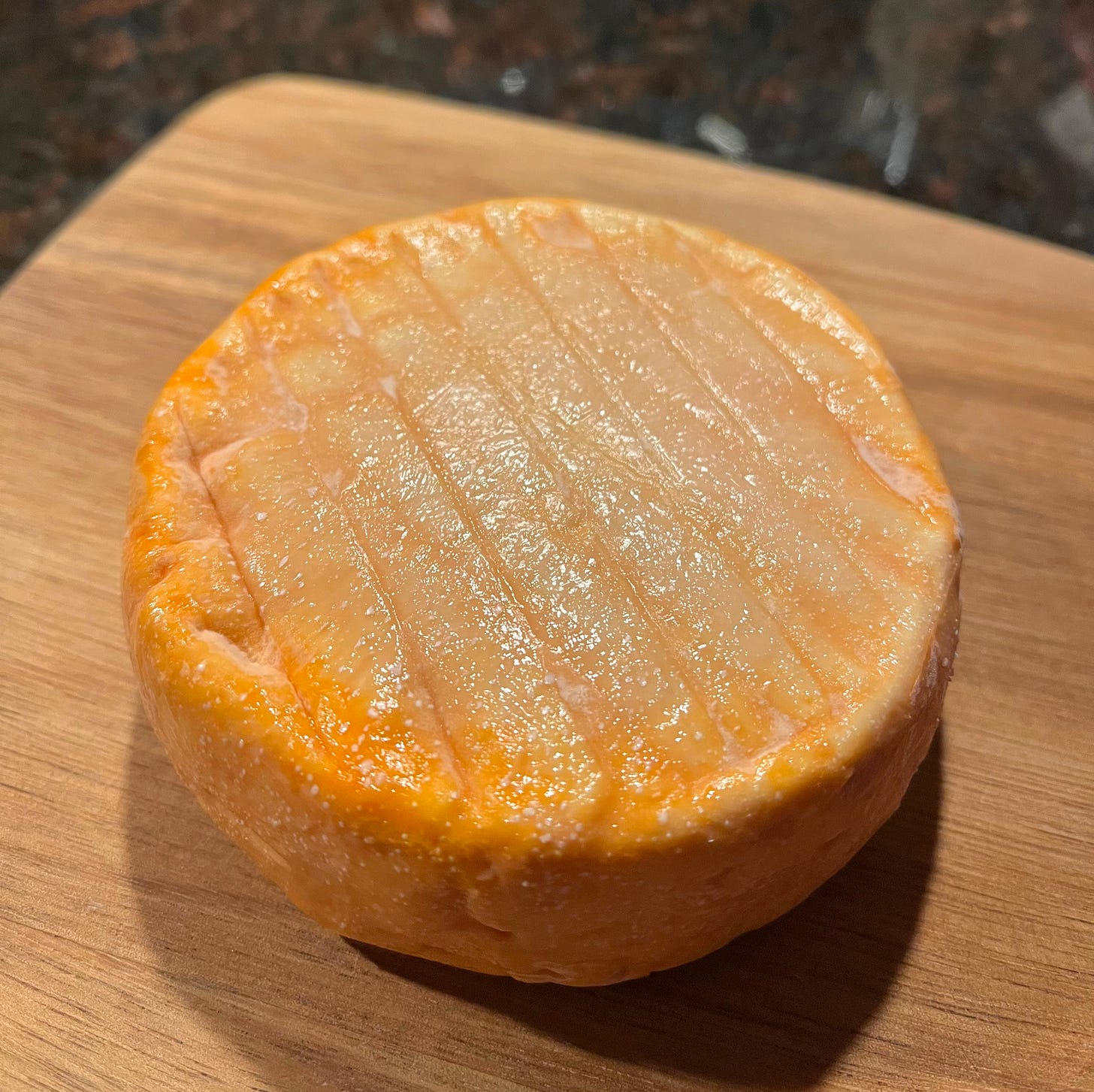Hi readers!
This week I thought I’d introduce you to washed rind cheeses — or “stinky” cheeses, as they are colloquially known.
I brought home a wheel of Willoughby last week1 — one of my fave washed rinds from Jasper Hill — and I’d honestly forgotten how much I freaking love this cheese.
It’s almost like a blend of the funk of a high quality Alpine cheese mixed with the decadent creaminess of a triple creme.
Plus it shares a name with one of Jane Austen’s best rogues.
Unless you have a delicate palette, what’s not to love?
Willoughby is a slightly stinky pillow of deliciousness made for people who love a little pungent flavor.
It’s better than any Taleggio you’ve had — at least on this side of the pond.
Willoughby is a washed rind cheese - meaning that it was “washed” during the aging process with a brine — sometimes containing beer or wine, creating the distinctive orange rind2.
Washed rind cheeses are stinky by their nature. Don’t be afraid. Willoughby is much stronger on the nose than it is on the palette.
However, if you don’t like strong flavors or something with a little funk, Willoughby might not be for you.
And that’s OK!
It’s not one of The Man’s favorites, either, and I have the highest respect for his taste.
When you unwrap a wheel of Willoughby, the smell hits you first. And the longer your wheel of Willoughby has aged, the stinkier it will be.
The French like a ripe cheese, and personally, I think that Willoughby is at its peak nearer to its “best by” date. But a lot of Americans are taken aback by that much flavor. And that’s cool. It’s an acquired taste. Eat cheese when you enjoy it!
Once you cut into the wheel, you’ll see that the inner paste is creamy and spreadable.
It’s the mix of the stinky rind and creamy paste that makes Willoughby so delectable.
You’ll find the flavor to be savory and beefy rather than buttery like a triple creme.
The edible rind should be soft — even a bit wet and slippery. All kinds of unpleasant odors of the sock laundry variety are perfectly normal.
However, the rind shouldn’t be too firm and the cheese should not have a strong ammonia smell. These are signs that the cheese is past its peak.
As for the history of washed rind cheeses — their origin can be traced to Europe’s medieval monasteries.
It was this sort of history that first drew me to the world of cheese and wine — it felt like my knowledge of medieval geography and culture was finally paying off.
In fact, by comparing the histories of washed rind cheeses with bloomy rind cheeses you can see the difference in lifestyle between medieval peasant households and those who joined monastic orders.
In my guide to bloomy rind cheeses, we learned that “brie style” cheeses were often produced for household consumption, pressed into small discs and left to ripen in the cellar — where they picked up the molds necessary to create their distinctive, pillowy white rind.
Peasant women had a lot to manage — so bloomy rind cheeses were “set it and forget it.”
Not so with washed rind cheeses. Because of the brine bathing required to produce the distinctive rind — these cheeses needed a more regimented routine.
Gotta bathe the cheese on a schedule to get the desired result.
Enter medieval monks.
To say that these guys led regimented lives is an understatement.
Their lives revolved around prayer — dictated by the Book of Hours — and these prayers were said at specific hours of the day, every day.
A monk had to stop what he was doing and attend these prayers at the indicated times.
Matins : the night office; the service recited at 2 am in the divine office
Lauds : the early morning service of divine office (approx 5am)
Prime : The 6am service
Terce : the second of the Little Hours of divine office, recited at the third hour (9 am)
Sext : the third of the Little Hours of divine office, recited at the sixth hour (noon)
Nones : the fourth of the Little Hours of the divine office, recited at the ninth hour (3 pm)
Vespers : the evening service of divine office, recited before dark (4 - 5pm)
Compline : the last of the day services of divine office, recited before retiring (6pm)
This daily routine — you had to do something between prayer times — lent itself to the activities of milking, pressing curds, and eventually washing the cheeses these monks made both to feed themselves and sell for profit.
Like the beers they are also famous for.
In fact, sometimes the beer was used in the brine.
Other washed rind cheeses to try:
Epoisses PDO4, France
Grayson, Meadow Creek Dairy, Virginia
The stinkiest of the stinky, Grayson used to make my sous chef cry when he had to cut it for cheese boards. When I was a monger, it was always inevitable that a customer would order a half pound of Grayson on days when I had a date. It lingers on the fingers, I’m telling you.
Kitty pic!
Life’s hard when you’re this adorable.
Until next time cheese (and cat!) lovers!
Curd Culture is a reader supported publication. Thank you for supporting my dream of using my cheese experience to make a difference on two issues I care about: sustainable family farming and animal welfare.
One of the perks of cheese mongering is bringing home the cheese that’s past its date.
The orange rind is a characteristic of the coryneform bacteria.
Yes, that Von Trapp family. They settled in Vermont after Climbing Every Mountain to flee Nazi Austria.
So stinky it is banned on the Paris Metro.








I think this may hit on what I see as the difference between a gourmet and a connoisseur. The latter is someone who knows about (in this case) cheese, likes it, and knows good from bad. A gourmet is all that plus they have broad tastes that include flavors and smells others might reject (like used gym socks). Gourmets are about exploring interesting flavors; connoisseurs (I think) tend to stick with what they like.
I am not a gourmet, but you clearly are! Willoughby doesn't sound appealing to me (although I do like harder Alpine cheeses), but I still enjoyed these posts. Fascinating to learn more about cheese!